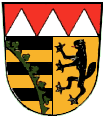Bibra family: Difference between revisions
→German: google book link |
|||
| Line 184: | Line 184: | ||
*[http://vonbibra.net Web site devoted to Bibra related topics] |
*[http://vonbibra.net Web site devoted to Bibra related topics] |
||
*[http://mdz10.bib-bvb.de/~db/bsb00001364/images/index.html?id=00001364&fip=62.245.226.186&no=79&seite=239 Wappenbuch Bertschi, Nikolaus: Wappen book - BSB Cod.icon. 308, Augsburg 1515 - 1650] |
*[http://mdz10.bib-bvb.de/~db/bsb00001364/images/index.html?id=00001364&fip=62.245.226.186&no=79&seite=239 Wappenbuch Bertschi, Nikolaus: Wappen book - BSB Cod.icon. 308, Augsburg 1515 - 1650] |
||
* [http://books.google.com/books?id=WzMPAAAAYAAJ&printsec=frontcover&source=gbs_v2_summary_r&cad=0#v=onepage&q&f=false Google Book ''Der Marktflecken Bibra'' 1892] |
|||
{{Commons|Bibra|Very Large Collection of Bibra Related Photos and Graphics}} |
{{Commons|Bibra|Very Large Collection of Bibra Related Photos and Graphics}} |
||
Revision as of 22:38, 11 May 2010



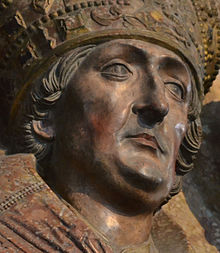

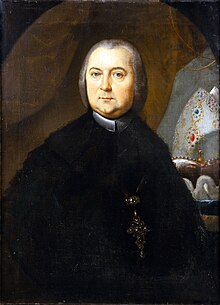
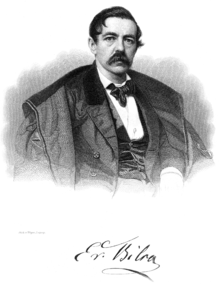
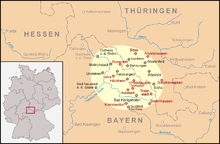
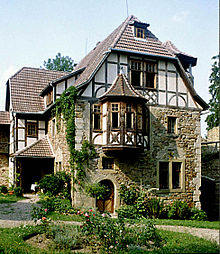



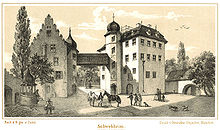

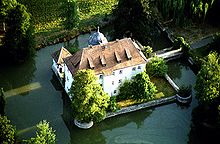
For other Bibra entries, go to Bibra disambiguation page
Bibra family was one of the leading (Uradel:very old Nobility) families in Franconia (northern part of Bavaria) and Thuringia from the mid 1400's to about 1600. Later on the family rose from Reichsritter (Imperial Knights) to Reichsfreiherr (Barons of the Holy Roman Empire). After the Holy Roman Empire dissolved, they were made ‘’Freiherr’‘ (Barons) of Bavaria and Bohemia.
History
Earliest references to the family include a document of Bishop Otto of Bamberg from the year 1119 of a Rupertus de Bibra. In 1151 a Pertholdus (Berthold) de Bibra and his sons Pertholdus (Berthold) and Tagino are referenced in another document. The family prospered in numbers, wealth, and influence in the 1400's and early 1500's. By the time of Siebmachers Wappenbuch of 1605, the family is listed as the most important family of Franconia under the rank of Freiherr. By 1600 most of the family died off without heirs partially due natural causes such as the Bubonic plague and the number of family members who took church positions. After the death of Heinrich von Bibra in 1602, the Prince-Bishop Julius Echter von Mespelbrunn seized most of the family’s assets as part of the Counter-Reformation resulting in a 79 year lawsuit. The lawsuit was eventually settled with the family receiving all the properties except Burgwallbach but without income during the suit. From 1602 on there were many important members of the family but the family itself never recovered the leading position it previously had in the late 1400's and 1500's. Between 1698 and 1772, the various lines were raised to Reichsfreiherr (Barons of the Holy Roman Empire). In later times, the family spread to the Austrian Empire, the British Empire, and the United States.
Prominent Members of the Family
- Dr. Kilian von Bibra (* about 1425; † 1494), December 1, 1450 Gilianus de Bibrach de Alemania receives doctorate in church law (doctoratus in iure canonico) in Padua, Italy, Dean of the Cathedral Chapter of Würzburg, Generalvicar of Bishopric of Würzburg, statesman (German Wikipedia article)
- Wilhelm von Bibra (*1442 † 1490), Lorenz’ half brother, Papal emissary
- Lorenz von Bibra, Prince-Bishop of Würzburg, Duke in Franconia (1459-1519)
- Conrad von Bibra , Prince-Bishop of Würzburg, Duke in Franconia (1490-1544)
- Christoph Erhard Frhr. von Bibra (1656-1706) participant at Battle of Blenheim, 12.10.1704 kaiserlichen (imperial) Generalfeldwachtmeister, 2.5.1705 (Elector of Mainz) Generalfeldmarschalleutnant (Lieutenant General), Commander of the Plassenburg and Kulmbach (German Wikipedia article)
- Johann Ernst Frhr. von Bibra (10.2.1662 - 19.8.1705) 12.4.1701 kaiserlichen (imperial) Feldmarschall-Leutnant, 11.5.1704 Reichsgeneralfeldmarschallleutnant, 20.5.1704 kaiserlichen (imperial) Feldzeugmeister (German Wikipedia article)
- Heinrich Carl Frhr. von Bibra (aka Karl Siegmund) (1666 + 1734) Franconian Circles, Bamberg Generalfeldmarschalleutnant (Lieutenant General), father Prince-Bishop Heinrich of Fulda, builder of the Bibra Palais (Bibra Haus) in Bamberg (German Wikipedia article)
- Heinrich von Bibra, (Karl Sigmund Frhr. von Bibra) Prince-Bishop, Prince-Abbot of Fulda (1711-1788) was Prince-Bishop from (1759-1788)
- Siegmund von Bibra (Philipp Anton Frhr. von Bibra; * 1750; † 1803), high official Bishopric and Abby of Fulda and editor of Journal von und für Deutschland (German Wikipedia article)
- Franz Ludwig von Bibra (1783 – 1823) was soldier, author, and early settler of Tasmania, Australia.
- Ernst Frhr. von Bibra (1806 † 1878), German Naturalist (Natural history scientist) and author. Ernst was a botanist, zoologist, metallurgist, chemist, geographer, travel writer, novelist, duellist, art collector and trailblazer in ethnopsychopharmacology.
- August Frhr. von Bibra (1808-1894) general manager of the Adelsverein, or Verein zum Schutze Deutscher Einwanderer in Texas ("Society for the Protection of German Immigrants in Texas").
- Wilhelm Franz Frhr. von Bibra (1824. + 1879) Generalfeldmarschalleutnant (Lieutenant General) Austro-Hungarian Army (German Wikipedia article)
- Sir Eric Ernest von Bibra (O.B.E., Kt.) (1895 - 1958) Order of the British Empire (1938) for services to local government & returned servicemen, Knight Bachelor (July 7, 1953) Agent-General for Tasmania in Britain, former Alderman and Mayor Launceston
- Sir Donald Dean von Bibra (C.M.G., O.B.E., K.B.) (1905 - 1982) Order of the British Empire (1970), Companion of the Order of St Michael and St George(1979), Knight Bachelor (1982): Former Chairman of the Australian Wool Industry Conference and Tasmanian grazier
- Eve von Bibra living actress and singer active in Australia
Nikolaus von Bibra, 1200's Erfurt monk, unknown if connected to von Bibra family. Listed under theology and satire, he wrote under the pseudonym Occultus Erfordernis and his satirical work is called Carmen Satiricum. (German Wikipedia article)
Riemenschneider Patronage
The tomb of Lorenz von Bibra by Tilman Riemenschneider (c. 1460 - July 7, 1531) in the Würzburg Dom (cathedral) is one of Riemenschneider's most famous works. Lorenz also commissioned Riemenscheider to do the tomb of his predecessor, Rudolf von Scherenberg. In Bibra the family commissioned Riemenschneider to do the Altar of the Apostles, Altar of the Church Fathers, Altar of the Annunciation, Carving of St. Kilian, a crucifix, and an epithet of Hans von Bibra (Lorenz’ father). Kilian von Bibra also commissioned a work by Riemenscheider other than at Bibra.
Localities Associated with Family
Family seat:
- Burg Bibra near Meiningen (c.1100 - present) is reportedly the longest continuously owned castle by a family in Thuringia having been in the family since written records began including during the East German period.
Second seat:
- Schloss Irmelshausen (1376-present) is a five sided water castle in Franconia, frequently featured in books and calendars.
Historical holdings still in family:
- Schloss Brennhausen (1681-present) is a unique and beautifully situated castle frequently featured in books and calendars.
- Dörfleshof farming estate (between Aubstadt and Ottelmannshausen)(c. 1848 - present)
Estates, castles, manor houses, and villages that previously came under Bibra control (Germany unless otherwise stated):
- Schloss Adelsdorf (1687-1993)
- Schloss Aschach (1391-1407)
- Aroldshausen (by Jüchsen) (c.1435-c.1990)
- Aubstadt (c.1308-after 1859)
- Burg Bramberg (1393-1483) pledge holding (Pfandschaft)
- Breuberg (Welkershausen by Meiningen) (1779- ?)
- Schloss Burgwallbach (1489-1681)
- Schloss Untereuerheim & Obereuerheim (1480-1687)
- Schloss Gemünda (by Seßlach) (1510-1655)
- Geroda (1400-1607)
- Gleicherwiesen (c.1356 - 1850)
- Höchheim (1356-c1970)
- Schloss Kleinbardorf (1413-1687) (see also Jewish Cemetery (Kleinbardorf))
- Neubrunn (Thuringia) (1366-1496+)
- Schloss Oselce (Czech Republic) (1808-1856)
- Schloss Roßrieth (by Mellrichstadt) (1438-1680)
- Schloss Schnabelwaid (1696 - 1750)
- Schwarza (Thuringian Forest) (1355-1425) pledge holding (Pfandschaft)
- Schloss Schwebheim (1513-c1958)
- Steinach an der Saale (1343 - ?) combination of fief and pledge
- Schloss Trappstadt (1853- c.1970)
- Burg Trimburg (1375-1412) pledge holding
- Walldorf (by Meinigen) (1779 - 1946)
- Schloss Weisendorf (c1750-1785)
- Schloss Willershausen (half 1757-1850)
German cities with close association:
Klosters closely associated with Bibra family:
- Rohr (just north of Meiningen) during the 1300s (last Bibra burial 1473)
- Henneberg Kloster Veßra in the 1400s.
Australia
- Bibra Lake, a suburb of Perth, Australia is named after Benedict von Bibra who in the summer of 1843 bought land there.
- Bibra’s Landing in the west coast of Australia is named after Francis Louis von Bibra and/or brother Charles who operated in the area in the 1870's-90's [1] (25°56′00″S 114°14′00″E / 25.93333°S 114.2333°E)
- Beaufront, Ross, Tasmania (1916 - present): a historical country home and large estate (42°03′47″S 147°30′35″E / 42.06296°S 147.50961°E)
Coat of Arms of Municipalities
The Bibra coat of arms is incorporated into several municipalities.
-
Gemeinde Adelsdorf
-
Gemeinde of Aubstadt
-
Former Gemeinde (now village) Bibra
-
Village of Gleicherwiesen
-
Gemeinde Höchheim
-
Village of Steinach an der Saale
Organization of the Family
For the last four centuries the family has divided itself between two Branches named after the two brothers whom all living Bibra descend: Valentine (1560 - 1595) and Bernhard (1562- 1609). Within each branch, the family has divided further in Lines centered on castles and a manor house (Gleicherwiesen). The last two centuries, the Lines are as follows:
Valentine Branch
- Adelsdorf Line (extinct in the male line since 1993)
- Raised to Imperial Barons (Reichsfreiherr) 1698
- Became Bavarian Barons 1815
- Raised to Imperial Barons (Reichsfreiherr) 1698
- Gleicherweisen Line
- Raised to Imperial Barons (Reichsfreiherr) 1698
- Became Bavarian Barons 1815
- Raised to Imperial Barons (Reichsfreiherr) 1698
- Schwebheim Line (extinct 1958)
- Raised to Imperial Barons (Reichsfreiherr) 1698
- Became Bavarian Barons 1817
- Raised to Imperial Barons (Reichsfreiherr) 1698
- Schnabelwaid, later Weisendorf Line (extinct 1856)
- Raised to Imperial Barons (Reichsfreiherr) 1698
- Became Bohemian Barons 1810
- Raised to Imperial Barons (Reichsfreiherr) 1698
Bernhard Branch
- Brennhausen Line
- Raised to Imperial Barons (Reichsfreiherr) 1772
- Became Bavarian Barons 1828
- Raised to Imperial Barons (Reichsfreiherr) 1772
- Bibra-Bibra Line
- Raised to Imperial Barons (Reichsfreiherr) 1772
- Became Bavarian Barons 1816
- Raised to Imperial Barons (Reichsfreiherr) 1772
- Irmelshausen Line (Older sub-line & Younger sub-line)
- Raised to Imperial Barons (Reichsfreiherr) 1713
- Became Bavarian Barons 1816
- Raised to Imperial Barons (Reichsfreiherr) 1713
All branches of the family were raised to Freiherr. Regarding personal names: Freiherr is a former title (translated as 'Baron'). In Germany since 1919, it forms part of family names. The feminine forms are Freifrau and Freiin. In 1919, all nobility predicates were transformed into constituents of the family name in Germany.
Outline of family




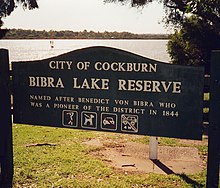
References
- ^ The Von Bibra Story Lois Nyman and Graeme von Bibra, November 1996, Foot & Playsted Pty Ltd., Launceston ISBN 0-9597188-1-8 pp. 64-66
German
- RHEINHOLD ALBERT: Chronik der Gemeinde Sulzdorf an der Lederhecke. (2 Volumes, zus. 860 S.) hrsg. von der Gemeinde Sulzdorf a. d. L., Verlag Frankenschwelle (Hildburghausen) Pages. 515 - 534. 1994. This is the most thorough source on Brennhausen.
- MARINA VON BIBRA, Heinrich VIII. - Fürstbischof von Fulda. In: Gerhard Pfeiffer (Hg.), Fränkische Lebensbilder, Bd. 4, Würzburg 1971, 213-229;
- WILHELM FRHR. VON BIBRA, Geschicte der Familie der Freiherrn von Bibra, 1870;
- WILHELM FRHR. VON BIBRA, Beiträge zur Familien Geschichte der Reichsfreiherrn von Bibra, Ernster Band (vol. 1), 1880;
- WILHELM FRHR. VON BIBRA, Beiträge zur Familien Geschichte der Reichsfreiherrn von Bibra, Zweiter Band (vol. 2), 1882;
- WILHELM FRHR. VON BIBRA, Beiträge zur Familien Geschichte der Reichsfreiherrn von Bibra, Dritter Band (vol. 3), 1888;
- A. GNAU, Das kirchliche Wirken Heinrich VIII. von Bibra, Fürstbischofs von Fulda (1759-1788), in: Mitteilungen des Historischen Vereins der Diözese Fulda 6 (1902) 12-19;
- JOHANN EBERHARD VON KAISER, Regierungsgeschichte des jetztigen Fürsten-Bischofs Heinrich des VIII. zu Fulda im Grundriße, Vornehmlich in Hinsicht der innern Landes-Anstalten und Verbesserungen, in: Patriotisches Archiv für Deutschland 2 (1785) 1-102;
- HANS KARLINGER, Die Kunstdenkmäler von Bayern, III, 13. Bezirksamt Königshofen. - Munich, 1915 (Reprint Munich, 1983, ISBN 3-486-50467-3)
- WERNER KATHREIN, Bibra, Heinrich, in: Erwin Gatz (Hg.), Die Bischöfe des Heiligen Römischen Reiches 1648-1803, Berlin 1990, 29f.;
- JOSEF LEINWEBER, Die Fuldaer Äbte und Bischöfe, Frankfurt a.M. 1989, 159-163;
- MICHAEL MÜLLER, Fürstbischof Heinrich von Bibra und die katholische Aufklärung im Hochstift Fulda (1759-88). Wandel und Kontinuität des kirchlichen Lebens, Fulda 2005;
- FRANZ SAYN-WITTGENSTEIN, Schlosser in Franken : Residenzen Und Landsitze Im Frankischen, 1974 ISBN 3406035752 ISBN 9783406035753;
- MARTIN STINGL, REICHFREIHEIT UND FÜRSTENDIENST DIE DIENSTBEZIEHUNGEN DER BIBRA 1500 BIS 1806, Verlag Degener & Co, 1994, 341 pages, ISBN 3-7686-9131-4;
- WERNER WAGENHÖFER, Die Bibra: Studien und Materialien zur Genealogie und zur Besitzgeschichte einer fränkischen Niederadelsfamilie im Spätmittelalter, Verlag Degener & Co, 1998, 699 pages, ISBN 3-7686-9147-0;
- WERNER WAGENHÖFER, Grablegen des Niederadels im Spätmittelalterlichen Franken - das Beispiel der Bibra, Wirtschaft - Gesellschaft - Mentalitäten im Mittelalter, Festschrift zum 75. Geburtstag von Rolf Sprandel, Franz Steiner Verlag, Stuttgart, 2006 ISBN 3-515-08882-2, ISBN 978-3-515-08882-4, Pages.335-359.
- ALFRED WENDEHORST, Das Bistum Würzburg: Teil 3. Die Bischofsreihe von 1455 -1617, 1978, ISBN 3-11-007475-3;
- PETER ADOLPH WINKOPP, Beiträge zur Lebensgeschichte Heinrich des achten Fürstbischofen zu Fulda, welcher am 25. September 1788 das Zeitliche mit dem Ewigen verwechselte, in: Der neue deutsche Zuschauer 1 (1789) 93-102.134-144;
- KLAUS WITTSTADT, Der Bibliotheksgründer Fürstbischof Heinrich VIII. von Bibra (1759-1788), in: Artur Brall (Hg.), Von der Klosterbibliothek zur Landesbibliothek. Beiträge zum zweihundertjährigen Bestehen der Hessischen Landesbibliothek Fulda (Stuttgart 1978) 269-293;
- F. ZWENGER, Heinrich v. Bibra. Fürstbischof von Fulda, in: BuBl 4 (1923) 139f., 143f., 148 [Weitgehend auf Wilhelm von Bibra beruhend];
English
- JULIEN CHAPUIS, Tilman Riemenschneider: Master Sculptor of the Late Middle Ages, National Gallery London Publications, October 11, 1999, ISBN 0300081626 ISBN 978-0300081626
- LOIS NYMAN AND GRAEME VON BIBRA, THE VON BIBRA STORY, Foot & Playsted Pty. Ltd., Launceston, Australia, 1996, ISBN 0-9597188-1-8;
- ERNST VON BIBRA Plant Intoxicants: A Classic Text on the Use of Mind-Altering Plants 1995 Translation of Die narkotischen Genussmittel und der Mensch Translated by Hedwig Schleiffer, Forward by Martin Haseneier and extensive technical notes by Jonathan Ot, an ethnobiologist- ISBN 0-89281-498-5;
- HILLAY ZMORA, State and nobility in early modern Germany: The knightly feud in Franconia 1440-1567, Cambridge University Press, 1997 (hardback), 2002 (paperback), ISBN 0 521 56179 5;
External links
- Heinrich von Bibra School
- University of Texas biography on AUGUST LUDWIG KARL GEORG FRIEDRICH VON BIBRA, (1808-1894), general manager of the Verein zum Schutze Deutscher Einwanderer in Texas
- Web site devoted to Bibra related topics
- Wappenbuch Bertschi, Nikolaus: Wappen book - BSB Cod.icon. 308, Augsburg 1515 - 1650
- Google Book Der Marktflecken Bibra 1892





